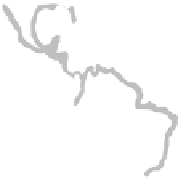Geoscience Reference
In-Depth Information
structure of the mangrove. These mangrove trees
and shrubs, in turn, promote sediment trapping
and may contribute abundant organic material to
the mangrove substrate. A fundamental feature
of both environments is their diversity in rela-
tion to geomorphological settings, their spatial
and, in the case of reefs, bathymetric extent, and
the sources and rates of sediment production
and accumulation. Change within these systems
can result from both natural and anthropogenic
disturbance. Such changes are capable of alter-
ing either the environmental parameters or the
substrates on which the biological components
depend and, as a result, of modifying sedimenta-
tion rates.
defined as biologically influenced, wave-resistant
build-ups of coral framework and carbonate
sediment within tropical and subtropical set-
tings, and which influence sediment deposition
in adjacent areas (Longman 1981; Rosen 1990).
Coral communities and coral reefs, however,
occur in a far wider range of settings, and form
a broader range of structures, than can be con-
strained by such traditional definitions. They
occur, for example, in a range of more marginal
settings (
sensu
Perry & Larcombe 2003), which
include higher latitude (subtropical to warm
temperate) environments, along with areas influ-
enced by high turbidity conditions and cool-water
upwelling (see section 9.1.3). Although these
environments may be characterized by reduced
rates of
in situ
calcium carbonate framework and
sediment production, and may ultimately produce
very different sedimentary deposits, they may
still have high coral cover and thus represent
important sites of coral-related carbonate pro-
duction. The coral-related sedimentary environ-
ment may thus better be defined as comprising
9.1.1 Distribution and occurrence of coral reefs
Coral reefs are typically associated with shallow,
warm, clear tropical and subtropical marine
settings (Fig. 9.1). They have been variously
described on the basis of their ecology and geo-
logy (see Riegl & Pillar 2000), and are commonly
120
o
E
180
o
60
o
E
120
o
W
60
o
W
0
o
60
o
N
60
o
N
Mean winter 15
°
C
sst isotherm
40
o
N
40
o
N
h
e
c
o
j
d
n
f
20
o
N
20
o
N
a
1
2
0
o
0
o
i
3
b
20
o
S
20
o
S
g
p
m
k
l
40
o
S
40
o
S
Mean 20
C winter
sst isotherm
°
1 - Niger
2 - Orinoco
3 - Amazon
Mangrove coastlines
Coral reef areas
Cool currents
Warm currents
0 2000 4000
km
60
o
S
60
o
S
Fig. 9.1
Global distribution of coral reefs and mangroves compared with mean 15°C and mean 20°C winter sea-surface temperature
isotherms. Latitudinal limits on the distribution of mangroves: a, St Louis, Senegal; b, Lobito, Angola; c, St George, Bermuda; d, St
Augustine, Florida; e, Chandeleur Islands, Louisiana; f, Rio Soto La Marina, Mexico; g, Aranangua River, Brazil; h, Puerto de Lobos,
Mexico; i, Piura River, Peru; j, Kiire, Kyushu, Japan; k, Raglan Harbour, New Zealand; l, Corner Inlet, Victoria; m, Leschenault Inlet,
Australia; n, Qatif, Trucial coast; o, Wadi-Kid, Sinai; p, Kei River, South Africa. (Adapted from Woodroffe & Grindrod 1991;
Hubbard 1997.)



























































































































































































































































